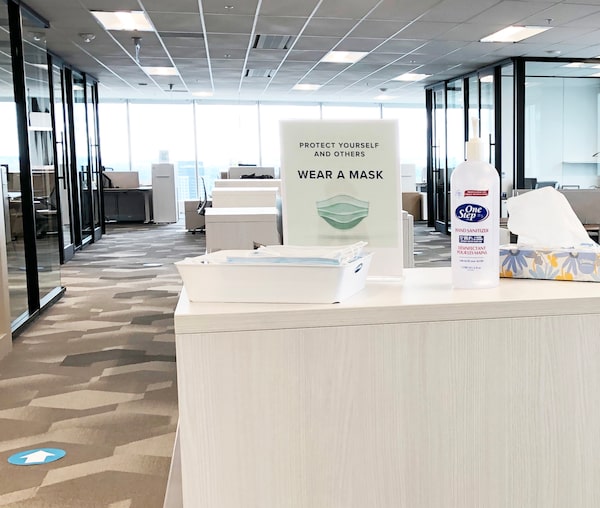
Wayfinding and sanitizing station at Avison Young Edmonton office.Avison Young/Supplied
The offices of commercial real estate service firm Avison Young in downtown Vancouver reopened in the first week of June after a total lockdown. But three months later, fewer than half of the 125 employees typically come in to the office on any given day, while the rest still work remotely.
“This is better than most offices; when I talk with tenants, many of them are still at 10 to 25 per cent occupancy,” says Aaron Burry, principal of Avison Young in Vancouver.
So far, such low turnouts have made it relatively simple to physically distance without reshuffling office furniture and there are only brief waits for elevators with capacity limits. But as people who have spent the summer working remotely decide to make the traditional fall return to office life, it poses significant challenges, property managers say.
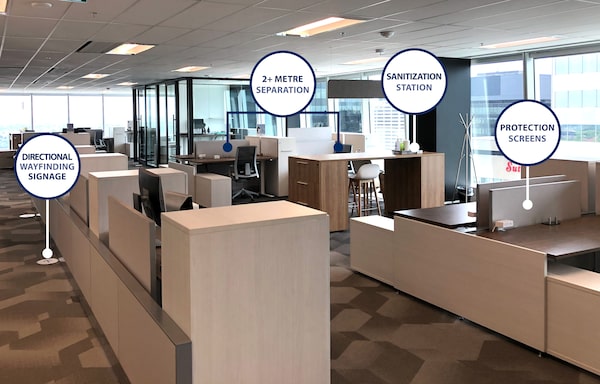
Safety features have been added to Avison Young's Edmonton office.Avison Young property management/Supplied
“There’s no question there’s a burnout. More and more people who at first loved working from home are becoming anxious to return and interact with colleagues,” says Stan Krawitz, vice-chairman, founder and head of commercial real estate services company Savills Canada. On top of that, “companies are starting to notice that while productivity for heads-down work hasn’t changed materially, productivity in creative, problem-solving and synergistic work is way, way off.”
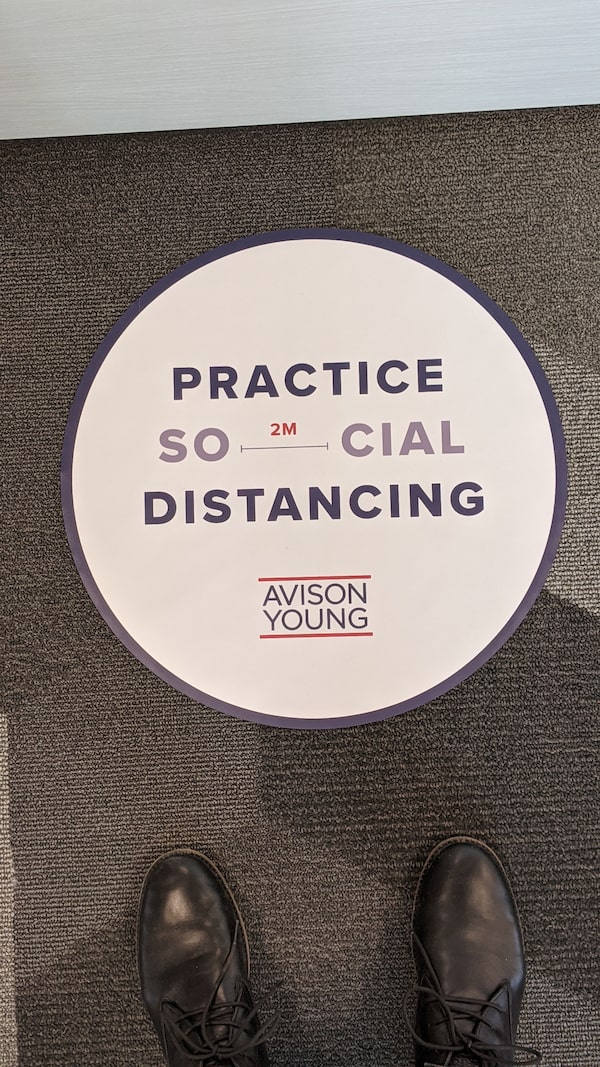
Floor sign at entrance to Avison Young.Avison Young/Supplied
Repopulating offices in the COVID-19 era could result in bottlenecks if everyone returns in the fall, he suggests. Even with fewer than a quarter of employees working in high rise towers in Canadian cities now, the wait times for elevators that are restricted to three or four riders a car can be as long as 20 minutes.
“If we see higher concentrations in the towers, the wait could be an hour. That could have a demotivating effect on people coming back … and that’s not a productive use of employees’ time,” Mr. Krawitz cautions.
For low-rise offices, the option is taking the stairs, says Sharon Turner, director of interiors for Canada at HOK, a design and architecture firm. “Most buildings have two sets of staircases for fire safety and we advise they make one flight directional up and the other set down. The last thing you want is people passing each other on the stairs huffing and puffing.” But even for those in very good shape, stair climbing to upper floors of high rises is impractical.
According to Ms. Turner, most office interiors are being adapted rather than completely redesigned because things are changing so quickly.
“Clients are often just blocking off desks to increase distance around work stations,” she says. “Some are putting in tall dividers, but not necessarily ceiling-high panels.”
“Often a planter will suffice to provide spacing,” she suggests.
Some companies are using apps on phones to notify employees how many are currently in the office and to allow them to reserve a work station on their way to work. Other apps that count movements can indicate when lavatories are unoccupied and, if busy, whether there are alternatives on another floor.
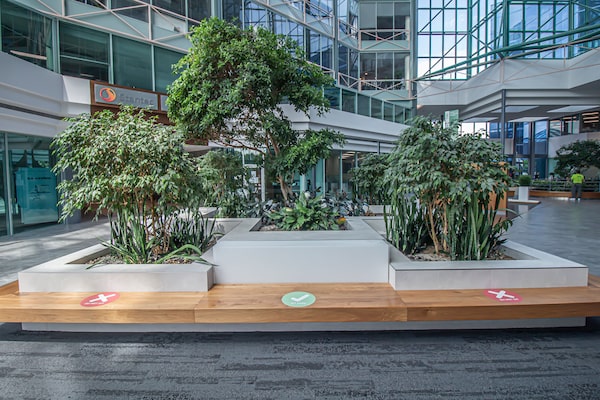
Sit here but not here - office lobby in Markham.Alex Heming/Supplied
Break rooms are also a significant issue, Ms. Turner says. Touchless coffee makers are on the market, although they are pricey. Refrigerators, microwaves and photocopiers need to have sanitizing wipes alongside for cleaning them after each use.
Les Miller, managing partner and chief executive of Crown Realty Partners in Toronto, believes that this emergency is speeding up environmental improvements that will make offices more attractive and productive in the future.
Ventilation and air filtration to prevent virus circulation is another concern for many returning to work. In Crown Realty’s offices at 400 University Avenue, says Mr. Miller, air filtration equipment is being cleaned more often and the filters have been upgraded to higher-spec devices that can remove up to 99.9 per cent of particles in the air.
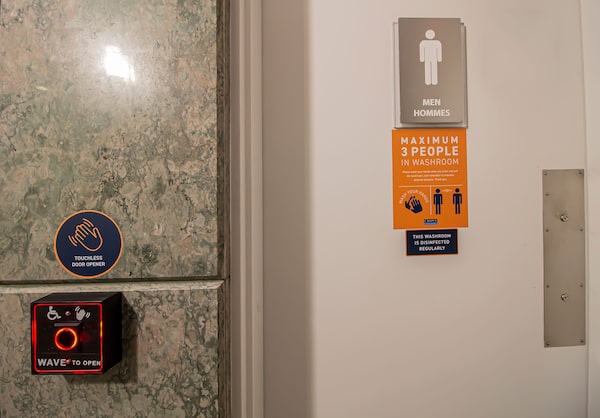
Touchless door opening, bathroom limited to three occupants in a Markham office building managed by Crown Realty.Alex Heming/Supplied
“Like anything else these systems cost more but they can also take care of pollen and odours that less expensive ones will not,” he says.
The focus on sanitation and physical distancing could force a rethink of the growing trend toward communal open offices, he adds. “The novelty of working at picnic tables and having no assigned seating is gone. I think there will be a reversion to assigned seating and maybe even a redevelopment of closed-in offices and acrylic dividers between desks. I firmly believe that people will want to know a work area is theirs and no one else has touched it.”
Half-occupancy may also continue for an extended duration even as office life resumes. That’s the case in the Edmonton office of Avison Young, where the current plan is to not exceed more than 50 per cent of the staff on site at one time, explains Scott Varga, senior project manager for Alberta.
“The staff is divided into Team A, who come in Monday, Wednesday and Friday, and Team B, who come in Tuesday and Thursday,” he explains. To date, the company has spent $500 on directional and procedural stickers and signage in the Calgary and Edmonton offices, he adds.
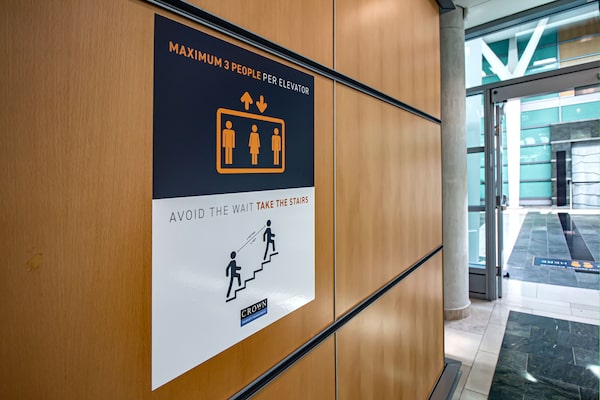
A signage encourages people to take the stairs at a low rise office building in Mississauga, managed by Crown Realty.Alex Heming/Supplied
Mr. Varga is convinced that a new sense of normalcy will develop over time. “At some point, people are going to feel comfortable working in the office again. Meanwhile, the economy needed a good kick in the butt to become more modern and efficient and that’s going to benefit the economy in the long run.”
Mr. Krawitz agrees; and because the situation is still fluid, he cautions landlords not to commit to major office rebuilding renovations. “Making massive changes to designs is foolish. The pendulum will swing back; maybe not to where it was before COVID, but things are not going to be stuck the way they are today, so spending money to make drastic changes is likely money poorly spent.”
Like any major shift, “the key is communication from leaders of organizations to have a clear plan and to continuously communicate the plan to the team and not overreact,” he says.
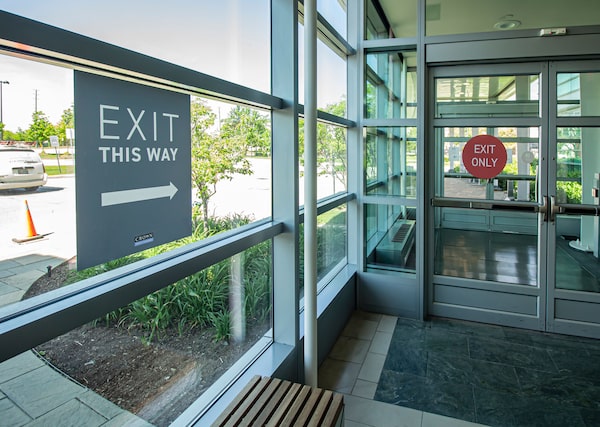
One way exit from lobby of Mississauga office building.Alex Heming/Supplied
A new era in office life
Here are some of the recommendations Avison Young makes for landlords adjusting to the COVID-19 era:
- There will be fundamental changes in when and how office space is used, owing to staggered employee shifts and rotating days of in-office work.
- Space needs may not shrink significantly. Reduced office occupancy will be offset by the need to provide more square footage per worker to accommodate physical-distancing measures.
- Buildings with better HVAC systems and technologies in place to reduce physical contact with high-touch points will likely attract more attention from potential tenants.
- Tenants may become more interested in lower floors, so employees can avoid elevators by using the stairs, and there will be a renewed demand for parking as employees avoid public transit.
- Professional and experienced property management is essential to ensure office spaces are cleaned properly and tenant concerns are addressed promptly.